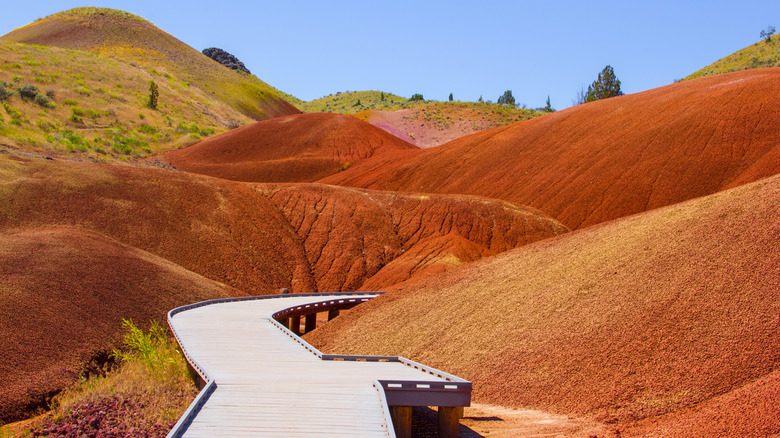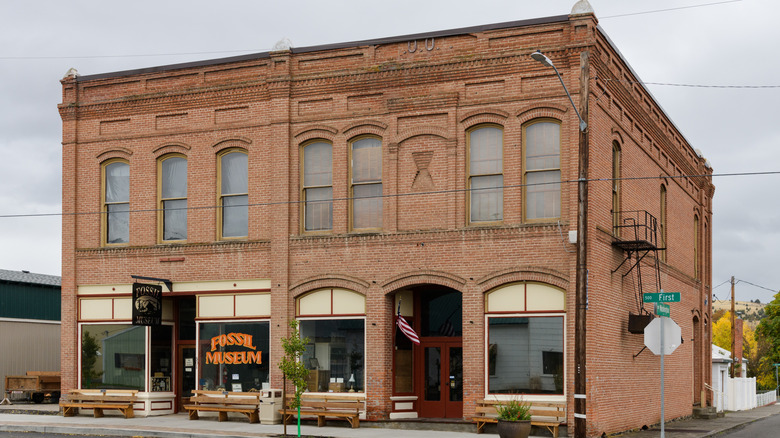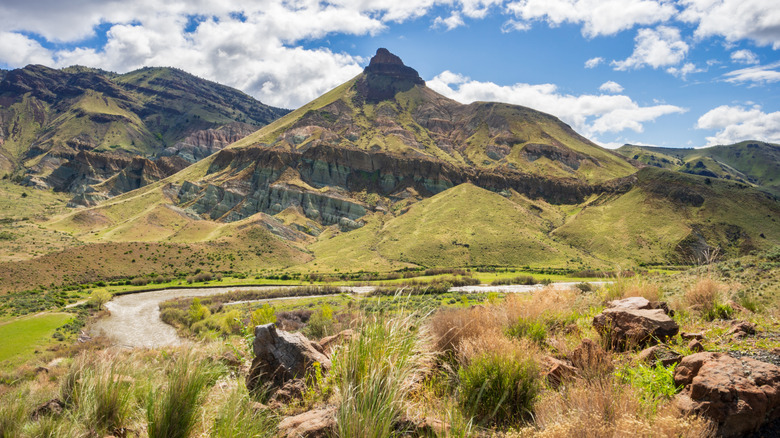Oregon's 'Hotbed Of Natural History' Is A Small City Surrounded By Fascinating Geological Sites
While nearly half of Oregon is made up of diverse forests, the other half (mainly in Eastern Oregon) is high desert. Within these deserts lie both mysteries and millions of years of history, wrapped in the incredible scenic beauty of sun-colored hills and rushing rivers. Similarly to how "America's aquarium in stone" tells the story of life in an ancient sea, the John Day Fossil Beds tell the story of Earth's terrestrial history, and are just a short drive from the city aptly named Fossil.
Fossil is a small hamlet that Travel Oregon calls a "hotbed of natural history." The small city gained its name in 1876 after Thomas Benton Hoover (the city's founder) named his post office after the fossils that he discovered on his ranch. Hoover and a friend moved the post office in 1881 to a better location near Butte and Cottonwood Creeks, and a small boomtown quickly sprang up along with Wheeler High School, the only public digging site in the area. The hills around Wheeler High are full of ancient leaves hidden in shale and are free to access year-round. You may be able to borrow a few basic tools, but it's recommended to bring a flathead screwdriver, chisel, trowel, rock pick hammer, and brush.
While the closest airport to Fossil is in Redmond, Oregon (roughly two hours away), consider flying into Portland instead. PDX offers far more flight options, though it is an additional hour away. If you're coming by car, Fossil and the John Day Fossil Beds are a key stop on Oregon's Journey Through Time Scenic Byway, an underrated and scenic road trip.
The storied history of Fossil, Oregon
The small city, with fewer than 450 residents, is the ideal base for a big outdoor adventure. Nearby, there's no shortage of vistas to climb or bass to be caught in the John Day River. If you're looking to experience life in the past, drive along the John Day River Farm Trail, where you'll find high-quality, locally-produced food and gifts made with passion, the old-fashioned way.
Being the county seat of Wheeler County, Fossil has a charming and historic downtown that can be explored in a few hours. Businesses, such as the Fossil Mercantile Company, have operated for over 100 years, offering a trip back in time alongside modern conveniences. KC's Country Value, the local hardware store, sells basic tools as well as outdoor gear you'll need to explore the wild and truly beautiful heart of Oregon. Just a block up the road, you'll find the Fossil Museum, an eclectic mix of unique artifacts from Fossil's past, including musical instruments, pinball machines, and an old bar. Newcomers such as Brenda's Blessings, a local cafe and pizzeria, are also beloved by the friendly locals and visitors. Per Tripadvisor and Google, the eatery has a 5-star rating, and you can't go wrong ordering anything on the menu.
Approximately 11 miles east of Fossil lies Kinzua, one of Oregon's more recent ghost towns. The city was a true company town, founded by the Kinzua Lumber Company in 1928, and shuttered when the company shut down and the land transformed into a forest. The town's 6-hole golf course, built in the 1930s, still stands and offers a unique way to play 18 and explore the local landscapes.
How to visit the John Day Fossil Beds
The three units of the John Day Fossil Beds National Monument cover over 14,000 acres and preserve 40 million years of history, with no major gaps. Here, archaeologists have unearthed fossils ranging from 7-foot tusks of the Columbian Mammoth to prehistoric ungulates and ancient semitropical plants. While it's possible to visit all three in a single day, it's not recommended, as each area is separated by one to two hours of driving on winding roads. If you need fuel and see an open gas station, stop and take a break, as services (including cell service) in the area are few and far between. Travelers looking for a true challenge should ride the Painted Hills Scenic Bikeway, which connects all three fossil beds and runs through Fossil and its neighboring towns.
Each unit offers a unique experience for visitors. The Clarno Unit and its towering palisades are less than 20 miles from Fossil and showcase real fossils on the short loop trail. The ancient Painted Hills Unit is often busy, with tourists mesmerized by the natural views, and the Sheep Rock Unit overlooks the Thomas Condon Visitor Center, a state-of-the-art museum and research lab with millions of years of fossils and history on display.
Plan your trip depending on your origin and destination, as there's no accommodation on site. After a long day of driving, rest easy back in Fossil at the Hyatt House Bed and Breakfast, or pitch a tent for $5 at the Service Creek Campground and Boat Launch. Alternatively, keep heading west to naturally breathtaking Bend, where you can wash down your adventure with a cold craft beer.


